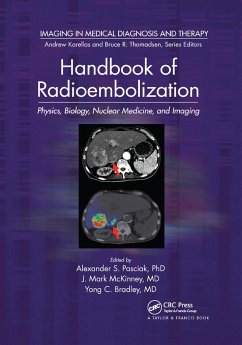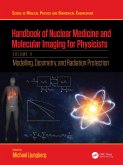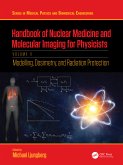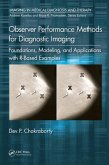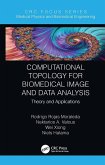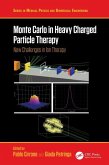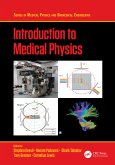Handbook of Radioembolization
Physics, Biology, Nuclear Medicine, and Imaging
Herausgeber: Bradley, Md.; Pasciak; McKinney, Md.
Handbook of Radioembolization
Physics, Biology, Nuclear Medicine, and Imaging
Herausgeber: Bradley, Md.; Pasciak; McKinney, Md.
- Broschiertes Buch
- Merkliste
- Auf die Merkliste
- Bewerten Bewerten
- Teilen
- Produkt teilen
- Produkterinnerung
- Produkterinnerung
Radioembolization is now the preferred treatment for both primary and secondary liver cancer. This handbook addresses the radiation biology, physics, nuclear medicine, and imaging for radioembolization using Yttrium-90 (90Y) microspheres, in addition to discussing aspects related to interventional radiology. The contents reflect new on-label hep
Andere Kunden interessierten sich auch für
![Handbook of Nuclear Medicine and Molecular Imaging for Physicists Handbook of Nuclear Medicine and Molecular Imaging for Physicists]() Michael LjungbergHandbook of Nuclear Medicine and Molecular Imaging for Physicists217,99 €
Michael LjungbergHandbook of Nuclear Medicine and Molecular Imaging for Physicists217,99 €![Handbook of Nuclear Medicine and Molecular Imaging for Physicists Handbook of Nuclear Medicine and Molecular Imaging for Physicists]() Michael Ljungberg (Lund Unive Department Medical Radiation PhysicsHandbook of Nuclear Medicine and Molecular Imaging for Physicists69,99 €
Michael Ljungberg (Lund Unive Department Medical Radiation PhysicsHandbook of Nuclear Medicine and Molecular Imaging for Physicists69,99 €![Observer Performance Methods for Diagnostic Imaging Observer Performance Methods for Diagnostic Imaging]() Dev P. ChakrabortyObserver Performance Methods for Diagnostic Imaging225,99 €
Dev P. ChakrabortyObserver Performance Methods for Diagnostic Imaging225,99 €![Computational Topology for Biomedical Image and Data Analysis Computational Topology for Biomedical Image and Data Analysis]() Rodrigo Rojas MoraledaComputational Topology for Biomedical Image and Data Analysis24,99 €
Rodrigo Rojas MoraledaComputational Topology for Biomedical Image and Data Analysis24,99 €![3D Image Reconstruction for CT and PET 3D Image Reconstruction for CT and PET]() Daniele Panetta3D Image Reconstruction for CT and PET69,99 €
Daniele Panetta3D Image Reconstruction for CT and PET69,99 €![Monte Carlo in Heavy Charged Particle Therapy Monte Carlo in Heavy Charged Particle Therapy]() Monte Carlo in Heavy Charged Particle Therapy175,99 €
Monte Carlo in Heavy Charged Particle Therapy175,99 €![Introduction to Medical Physics Introduction to Medical Physics]() Introduction to Medical Physics102,99 €
Introduction to Medical Physics102,99 €-
-
-
Radioembolization is now the preferred treatment for both primary and secondary liver cancer. This handbook addresses the radiation biology, physics, nuclear medicine, and imaging for radioembolization using Yttrium-90 (90Y) microspheres, in addition to discussing aspects related to interventional radiology. The contents reflect new on-label hep
Hinweis: Dieser Artikel kann nur an eine deutsche Lieferadresse ausgeliefert werden.
Hinweis: Dieser Artikel kann nur an eine deutsche Lieferadresse ausgeliefert werden.
Produktdetails
- Produktdetails
- Imaging in Medical Diagnosis and Therapy
- Verlag: Taylor & Francis Ltd
- Seitenzahl: 330
- Erscheinungstermin: 12. Dezember 2019
- Englisch
- Abmessung: 177mm x 254mm x 19mm
- Gewicht: 810g
- ISBN-13: 9780367874681
- ISBN-10: 0367874687
- Artikelnr.: 58482458
- Herstellerkennzeichnung
- Libri GmbH
- Europaallee 1
- 36244 Bad Hersfeld
- gpsr@libri.de
- Imaging in Medical Diagnosis and Therapy
- Verlag: Taylor & Francis Ltd
- Seitenzahl: 330
- Erscheinungstermin: 12. Dezember 2019
- Englisch
- Abmessung: 177mm x 254mm x 19mm
- Gewicht: 810g
- ISBN-13: 9780367874681
- ISBN-10: 0367874687
- Artikelnr.: 58482458
- Herstellerkennzeichnung
- Libri GmbH
- Europaallee 1
- 36244 Bad Hersfeld
- gpsr@libri.de
Alexander S. Pasciak, PhD, earned a BS in electrical engineering at the University of Washington, MS in health physics and PhD in nuclear engineering at Texas A&M University. In 2010, Dr. Pasciak completed a 2-year diagnostic medical physics residency at the University of Texas MD Anderson Cancer Center after which he worked for 5 years as a diagnostic medical physicist at the University of Tennessee Medical Center in Knoxville, Tennessee. Dr. Pasciak maintains a position as an associate professor of radiology at the University of Tennessee and is concurrently pursuing his MD degree at the Johns Hopkins University School of Medicine in Baltimore, Maryland. Dr. Pasciak is active in multiple research endeavors in the fields of interventional radiology and medical physics, and he has published papers in high impact journals. Dr. Pasciak has published 35 articles in peer-reviewed medical journals, presented 62 research abstracts at national meetings, has written 6 book chapters, and has filed 2 patents. He currently serves as principal investigator on three externally funded research grants involving radioembolization. Dr. Pasciak is certified by the American Board of Radiology (ABR) in diagnostic medical physics and is Mammography Quality Standards Act (MQSA) qualified. J. Mark McKinney, MD, earned a medical degree at Loma Linda University School of Medicine in California where he completed a diagnostic radiology residency and interventional radiology fellowship. Dr. McKinney joined the Mayo Clinic in 1993. While at Mayo Clinic in Jacksonville, Florida, he developed the interventional radiology fellowship, mentored residents, made numerous presentations, and authored more than 60 peer-reviewed articles, abstracts, and book chapters. From 2008 to 2012 Dr. McKinney was Chair of Radiology at the University of Tennessee Medical Center and initiated the University of Tennessee interventional oncology radioembolization program.
INTRODUCTION. Introduction to radioembolization for the treatment of
non-resectable liver cancer. PATIENT SELECTION AND TREATMENT PLANNING.
Treatment options for patients with primary and secondary liver cancer: An
overview of invasive, minimally invasive and non-invasive techniques.
Treatment planning part I: Vascular considerations. Treatment planning part
II: Procedure simulation using 99mTc-MAA. Treatment planning part III:
Dosimetric considerations in conventional lobar therapy. Treatment planning
part IV: Radioembolization in segmentectomy, lobectomy and future liver
remnant hypertrophy. TREATING PATIENTS WITH RADIOEMBOLIZATION. Radiation
safety concerns associated with preparing the dose, treating and releasing
the patient and managing radioactive waste. The radiation biology of
radioembolization. Glass and resin microspheres: An analysis on a
microscopic and macroscopic level. FOLLOWING PATIENTS TREATED WITH
RADIOEMBOLIZATION. Quantitative post-radioembolization imaging using
Bremsstrahlung SPECT. Quantitative post-radioembolization imaging using
PET/CT. Image-based 3-dimensional dosimetry following radioembolization.
Diagnostic reporting using post-radioembolization imaging. Using
post-treatment imaging in the medical management of patients treated with
radioembolization. The potential utility of serial therapy in
radioembolization: A radiation biology analysis. NEW HORIZONS. Future
directions in radioembolization for intrahepatic and extrahepatic treatment
of disease
non-resectable liver cancer. PATIENT SELECTION AND TREATMENT PLANNING.
Treatment options for patients with primary and secondary liver cancer: An
overview of invasive, minimally invasive and non-invasive techniques.
Treatment planning part I: Vascular considerations. Treatment planning part
II: Procedure simulation using 99mTc-MAA. Treatment planning part III:
Dosimetric considerations in conventional lobar therapy. Treatment planning
part IV: Radioembolization in segmentectomy, lobectomy and future liver
remnant hypertrophy. TREATING PATIENTS WITH RADIOEMBOLIZATION. Radiation
safety concerns associated with preparing the dose, treating and releasing
the patient and managing radioactive waste. The radiation biology of
radioembolization. Glass and resin microspheres: An analysis on a
microscopic and macroscopic level. FOLLOWING PATIENTS TREATED WITH
RADIOEMBOLIZATION. Quantitative post-radioembolization imaging using
Bremsstrahlung SPECT. Quantitative post-radioembolization imaging using
PET/CT. Image-based 3-dimensional dosimetry following radioembolization.
Diagnostic reporting using post-radioembolization imaging. Using
post-treatment imaging in the medical management of patients treated with
radioembolization. The potential utility of serial therapy in
radioembolization: A radiation biology analysis. NEW HORIZONS. Future
directions in radioembolization for intrahepatic and extrahepatic treatment
of disease
INTRODUCTION. Introduction to radioembolization for the treatment of
non-resectable liver cancer. PATIENT SELECTION AND TREATMENT PLANNING.
Treatment options for patients with primary and secondary liver cancer: An
overview of invasive, minimally invasive and non-invasive techniques.
Treatment planning part I: Vascular considerations. Treatment planning part
II: Procedure simulation using 99mTc-MAA. Treatment planning part III:
Dosimetric considerations in conventional lobar therapy. Treatment planning
part IV: Radioembolization in segmentectomy, lobectomy and future liver
remnant hypertrophy. TREATING PATIENTS WITH RADIOEMBOLIZATION. Radiation
safety concerns associated with preparing the dose, treating and releasing
the patient and managing radioactive waste. The radiation biology of
radioembolization. Glass and resin microspheres: An analysis on a
microscopic and macroscopic level. FOLLOWING PATIENTS TREATED WITH
RADIOEMBOLIZATION. Quantitative post-radioembolization imaging using
Bremsstrahlung SPECT. Quantitative post-radioembolization imaging using
PET/CT. Image-based 3-dimensional dosimetry following radioembolization.
Diagnostic reporting using post-radioembolization imaging. Using
post-treatment imaging in the medical management of patients treated with
radioembolization. The potential utility of serial therapy in
radioembolization: A radiation biology analysis. NEW HORIZONS. Future
directions in radioembolization for intrahepatic and extrahepatic treatment
of disease
non-resectable liver cancer. PATIENT SELECTION AND TREATMENT PLANNING.
Treatment options for patients with primary and secondary liver cancer: An
overview of invasive, minimally invasive and non-invasive techniques.
Treatment planning part I: Vascular considerations. Treatment planning part
II: Procedure simulation using 99mTc-MAA. Treatment planning part III:
Dosimetric considerations in conventional lobar therapy. Treatment planning
part IV: Radioembolization in segmentectomy, lobectomy and future liver
remnant hypertrophy. TREATING PATIENTS WITH RADIOEMBOLIZATION. Radiation
safety concerns associated with preparing the dose, treating and releasing
the patient and managing radioactive waste. The radiation biology of
radioembolization. Glass and resin microspheres: An analysis on a
microscopic and macroscopic level. FOLLOWING PATIENTS TREATED WITH
RADIOEMBOLIZATION. Quantitative post-radioembolization imaging using
Bremsstrahlung SPECT. Quantitative post-radioembolization imaging using
PET/CT. Image-based 3-dimensional dosimetry following radioembolization.
Diagnostic reporting using post-radioembolization imaging. Using
post-treatment imaging in the medical management of patients treated with
radioembolization. The potential utility of serial therapy in
radioembolization: A radiation biology analysis. NEW HORIZONS. Future
directions in radioembolization for intrahepatic and extrahepatic treatment
of disease

